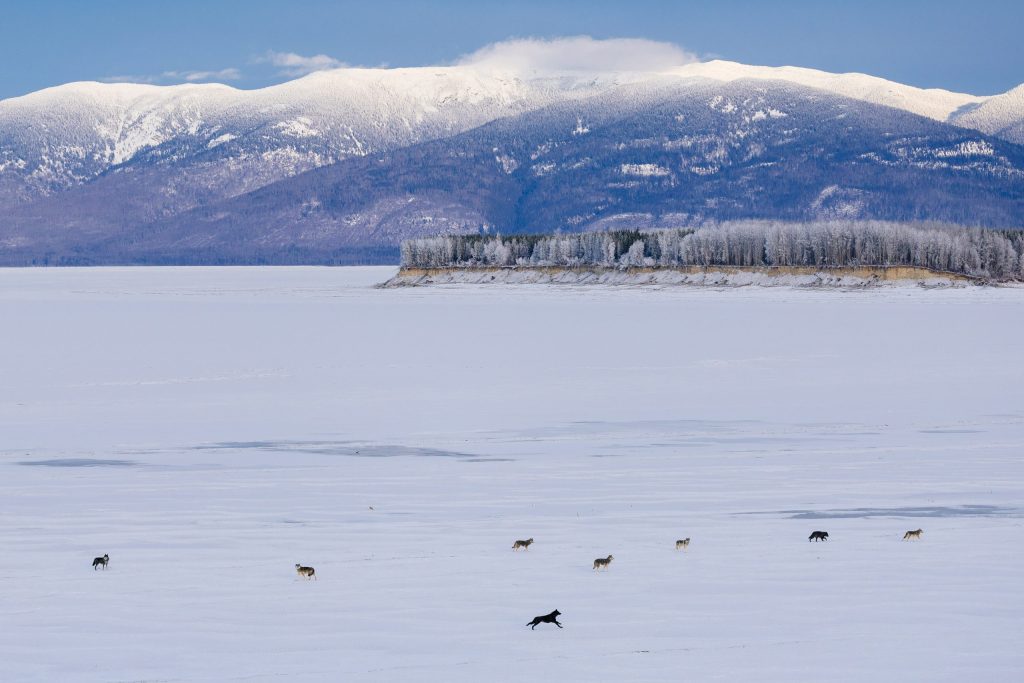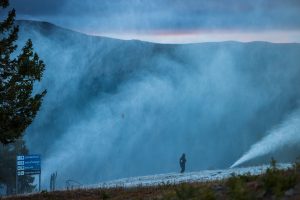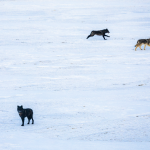Could Colorado see widespread ecosystem changes from wolf restoration?
Researchers disagree on whether wolves are causing a trophic cascade in Yellowstone

Colorado Parks and Wildlife (CPW)
In Yellowstone National Park — where gray wolves were reintroduced starting in 1995 — researchers have gone back and forth on whether the restoration of wolves has impacted the ecosystem.
The idea is referred to as a “trophic cascade,” where a change in an ecosystem’s food chain — typically the removal or reintroduction of an apex predator like wolves — has a ripple effect on the other levels in the food chain and ecosystem. This can include changes to other species, plant life, the environment and more.
Brenna Cassidy, Colorado Parks and Wildlife’s wolf monitoring and data coordinator, referred to whether wolves contribute to these ecosystem changes as “one of the most hotly debated topics in wolf ecology.”
Cassidy spent nearly 15 years working with wolves across the West, including in Yellowstone National Park, prior to joining the state wildlife agency in October 2023.
“There are some researchers who point to wolves being the cause of that (trophic cascade) change,” Cassidy said. “There are some researchers who don’t.”
The differing opinions are reflected in some of the latest studies on the topic in Yellowstone. In October, two studies published in the Forest Ecology and Management from researchers at Oregon State University have tied Yellowstone’s restoration of wolves to a trophic cascade in the national park — one relating it to changes in aspen trees and another to willow growth. A paper published in the same journal, however, criticized the methodology.
In the report on aspens, it claims that as wolves were reintroduced, elk browsing was reduced and resulted in the growth of aspen saplings for the first time in decades in northern Yellowstone.
“The reintroduction of large carnivores has initiated a recovery process that had been shut down for decades,” Luke Painter, one of the study’s lead authors, said in a news release. “Wolf reintroduction is yielding long-term ecological changes contributing to increased biodiversity and habitat diversity.”
Less scrolling. More knowing.
Sign up for daily or weekly newsletters at SummitDaily.com/newsletter
The report also notes that the increase in bison numbers in other areas of the park may be constraining aspen growth.
The report on willows claimed a similar relationship, reporting that the impacts on elk grazing brought on by wolf reintroduction led to increased growth of willows over a 20-year study period. Painter, Robert Beschta and William Ripple were all lead authors on both studies.
The rebuttal does question whether the methodology is flawed and claims that evidence of a trophic cascade is “weak.” Specifically, it claims the research omits key factors like how hunting has reduced elk density, overestimates the height of willows and more.
“Far from indicating a strong, system-wide cascade, the current evidence points to a more complex and constrained outcome — one that underscores the importance of analytical rigor and ecological context in evaluating the consequences of large carnivore recovery,” the rebuttal states.
The response mirrors and cites claims made in a 2024 study from Colorado State University researchers. This study concluded that at the same time wolves were restored in Yellowstone, previously depleted mountain lion and grizzly bear populations began to see natural recovery, which helped stabilize the ecosystem. It claims that all the predator populations rebounding — as well as human hunting of elk — played a role in the elk population declines.
It also reports that the rise of bison populations means that browsing of woody food sources, like willows, has not declined in proportion to the drop in elk. The study included research done by the authors in the park’s northern range starting in 2001.
“When you disturb ecosystems by changing the makeup of a food web, it can lead to lasting changes that are not quickly fixed,” said Toms Hobbs, one of the report’s lead authors and professor emeritus at Colorado State University, in a press release. “We can’t rule out the possibility that the ecosystem will be restored over the next 40 years as a result of the return of apex predators. All we can be sure of is what’s observable now — the ecosystem has not responded dramatically to the restored food web.”
The takeaway, Hobbs added, is not to lose these apex predators in the first place, as they lead to healthier ecosystems.
Will Colorado see ecosystem changes as a result of its wolf restoration?
As researchers debate whether the reintroduction of wolves has led to strong trophic cascades, a similar debate could sprout in Colorado as it wraps up the second year in its wolf restoration.
In the 2024 report, Hobbs and his co-author, David Cooper, a research scientist emeritus at Colorado State University, noted that wolves may not cause immediate ecosystem improvements, but would still have positive impacts. The authors also acknowledged differences in the management of elk populations between Yellowstone and Colorado — namely that Colorado has not seen negative impacts from excessive elk grazing as Yellowstone had.
Cooper, in a press release, said “wolves are important components of ecosystems.”
“They will have some ecosystem benefits by reducing some large herbivore populations,” Cooper added. “Over the next hundred years, they’ll have a greater role in regulating some of the ecological processes that we’ve been studying.”
When asked about whether Colorado could see these types of impacts, Cassidy noted that, in general, trophic cascades are “very hard to detect through research” because of all the moving pieces in any ecosystem. This includes all the animal species, plant species and climate impacts like precipitation, temperature and soil health.
“It’s so complex that it’s really hard to detect not only just a trophic cascade, but why that’s happening,” Cassidy said. “It’s a hard thing to detect on a scale like Yellowstone. It’s even harder to detect something that is on a statewide scale.”
In Colorado, considerations would have to be made around hunting, development, water use and more.
Regardless, as Colorado is still so early in its wolf reintroduction — with at least one more release of 10 to 15 wolves planned for this winter — it will be a long time before this can even be looked at.
“If there is some sort of trophic cascade or effects on the ecological community in Colorado, it’s not something that can be pointed to right away and it will be very, very hard to detect something going on,” Cassidy said. “There are some researchers who are very aware of all those challenges and working to come up with research programs that will be monitoring this, but it is not something that we should expect to be able to detect as scientists for a while.”

Support Local Journalism

Support Local Journalism
As a Summit Daily News reader, you make our work possible.
Summit Daily is embarking on a multiyear project to digitize its archives going back to 1989 and make them available to the public in partnership with the Colorado Historic Newspapers Collection. The full project is expected to cost about $165,000. All donations made in 2023 will go directly toward this project.
Every contribution, no matter the size, will make a difference.










